Posted by Elena del Valle on March 13, 2009

Clutter, Chaos and the Cure book cover
In her 98-page paperback book, Clutter, Chaos and the Cure or Why You Never Misplace Your Toothbrush (Kiwi Publishing, 9.95) Rosemary Chieppo, a professional organizer, explains why we have clutter in our lives and how to deal with it. The easy-to-read book is divided into 27 short sections addressing related topics.
She promises to help readers develop habits to find what they need when they need it; gain time to do other things (instead of searching for misplaced items); eliminate time wasters; control interruptions; develop a system to determine what to keep and what to discard; reduce clutter; and prevent a clutter relapse.
“Organizing just means having a place for everything and making sure everything is in its place,” said Chieppo, a member of the National Association of Professional Organizers. According to her, many people think of organizing in terms of physical space but they should remember that there is an emotional and mental side. “They don’t own their stuff. Their stuff owns them. Bringing themselves to donate or discard an item of sentimental value takes a certain amount of self-reflection.”
The book includes illustrations by Ernie Conte, a 30-year veteran illustrator and graphic designer. He was formerly staff artist and art director at Lender’s Bagels. Since 1999, Chieppo, of Born to Organize, has made a living helping people get organized.

Clutter, Chaos and the Cure
Click here to buy Clutter, Chaos & the Cure
Comments:
Filed Under: Books
Posted by Elena del Valle on March 6, 2009

Chronicles of a Nomad book cover
Photos: A.A. Alvarez
In his first novel, Chronicles of a Nomad: Memoirs of an Immigrant (A.A. Alvarez Publishing, $15), Venezuelan born A.A. Alvarez shares a tale of life following immigration based in part on his personal experiences as an immigrant from his native country to Greece. He began writing the 279-page paperback novel in May 2008 and the book was published January 2009.
Told in first person by the fictional character Carlos Rodriguez, the book shares the story of a young man searching for his future beyond his country of birth, where he no longer feels safe or welcome. He first travels to the United States but an expired visa forces his return to his native country.
Eventually, he immigrates to an unexpected place, Greece. Along the way, he shares his tale with readers as well as his thoughts about immigration, love, family, culture, politics, and religion.
“When I wrote Chronicles of a Nomad: Memoirs of an Immigrant, I imagined a readership composed of international students who wanted to enjoy an easy read in which they could feel a special connection with the main character. Leaving one’s country, one’s culture, and one’s language behind is an experience that only us immigrants can truly understand. It is a bond that unites us all regardless of origin and I believe that every migrant has a story worth sharing with the world. It would be wonderful if this could encourage them to publish their stories as well,” said Alvarez.
“As I got close to finishing my book, I began to also imagine immigrant parents sharing the story with their kids. After all, it’s the story of a young man who deals with plenty of the issues that many young immigrants also have to deal with, not only as foreigners in a new country, but as teenagers in their homeland and as human beings of planet Earth. My book serves as a medium for me to share some of the teachings I’ve learned in my path to becoming a citizen of the world, and it’s my greatest honor that it can be enjoyed by a multicultural audience.”

A.A. Alvarez, author, Chronicles of a Nomad
Alvarez left his native country after witnessing a major economic disaster, several bloody revolts, and two failed coup attempts. He lives in Greece where he works in marketing and copy writing.

Click here to buy Chronicles of a Nomad: Memoirs of an Immigrant
Comments:
Filed Under: Books
Posted by Elena del Valle on February 27, 2009

Who’s Buying by Race and Hispanic Origin (New Strategist, $59.95) is part of the Who’s Buying series and features 123 pages of spending information about Asian, black and Hispanic consumers in 2005. The paperback book is divided into 12 sections and four appendices.
Following a Household Spending Trends discussion for 2000 to 2005, there is an overview followed by information on spending apparel, entertainment, financial products and services, food and alcoholic beverages, gifts, healthcare, housing, and transportation shelter and utilities. There is also a section on personal care, reading, education and tobacco. The appendices address the Consumer Expenditure Survey, Mortgage Principal and Capital Improvements and Spending by Product and Service Ranked by Amount Spent.
New Strategist is a New York publishing company. Other titles published by the company include Household Spending, Who’s Buying for Travel, Who’s Buying Apparel, Who’s Buying Health Care, Who’s Buying Household Furnishings, Services and Supplies, Who’s Buying for Pets, Who’s Buying by Race and Hispanic Origin, Who’s Buying at Restaurants and Carry-Outs, Who’s Buying Transportation, Who’s Buying Groceries, Who’s Buying Entertainment, Who’s Buying by Age and Who We are Hispanic.
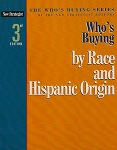
Click here to buy Who’s Buying by Race and Hispanic Origin
Comments:
Filed Under: Books
Posted by Elena del Valle on February 20, 2009
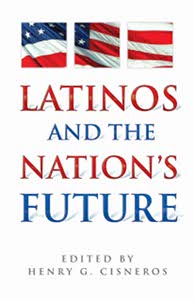
Latinos and the Nation’s Future book cover
Photos: Arte Publico Press
In Latinos and the Nation’s Future (Arte Publico Press, $29.95) 15 individuals, 11 men and four women, share their thoughts about Latinos in the United States. Each writer contributed one chapter, except Nicolas Kanellos, Ph.D. who contributed two chapters. The 248-page hardcover book was edited by Henry G. Cisneros, chairman of American CityVista, and John Rosales, co-editor of Casa y Comunidad: Latino Home and Neighborhood Design (Builder Books). Cisneros also contributed the first chapter, An Overview: Latinos and the Nation’s Future.
The book is divided into four parts: Latino Visions: Past, Present and Future; Latinos and the Larger Society; Raw Numbers and Their Impact; and Final Thoughts. In addition to Cisnero’s overview the first section includes three chapters: The Latino Presence: Some Historical Background by Nicolas Kanellos, Ph.D., founder and publisher, Arte Publico Press; Liberty and Justice for All: Civil Rights in the Years Ahead by Raul Izaguirre, executive director, Center for Community Development and Civil Rights at Arizona State University; and Becoming American – The Latino Way by Tamar Jacoby, president and chief executive officer, Immigrationworks USA.
The second section is divided into six chapters: Increasing Hispanic Mobility into the Middle Class: An Overview by Harry P. Pachon, Ph.D., professor of public policy, University of Southern California; Latino Small Business: A Big Present, A Bigger Future by Aida M. Alvarez, board member of Wal-Mart and Union BanCal Corp/Union Bank of California; Making the Next Generation Our Greatest Resource by Sarita E. Brown, president, Excelencia in Education; La Gran Oportunidad Up for Grabs The Hispanic Opportunity by Joe Garcia, a former Democratic candidate for Congress in South Florida; Politics and the Latino Future: A Republican Dream by Lionel Sosa, an advertising executive; and Latino Progress and U.S. Foreign Policy by Sergio Muñoz Bata, a journalist.
Part three of the book includes four chapters: The Raw Numbers: Population Projections and the Power of Hispanic Demographic Change by Leobardo F. Estrada, Ph.D., associate professor, UCLA School of Public Affairs; Latino Numbers and Social Trends: Implications for the Future by Roberto Suro, professor of journalism, University of Southern California Annenberg School for Communication; A First-Order Need: Improving the Health of the Nation’s Latinos by Elena V. Rios, M.D., M.S.P.H., president and chief executive officer, National Hispanic Medical Association; and Housing the Nation’s Latinos: An Overview by Saul N. Ramirez, Jr., executive director, National Association of Housing and Redevelopment Officials.
The final section only has two chapters: On the Power of Education and Community Action by Ernesto Cortes, Southwest regional director, Industrial Areas Foundation; and Toward the New American Dream by Kanellos.

Henry G. Cisneros
Cisneros is a former Secretary of the U.S. Department of Housing and Urban Development and former mayor of San Antonio, Texas. Previously, he was president and chief operating officer, Univision Communications in Los Angeles, California. He has a doctorate degree in public administration from George Washington University.

Click here to buy Latinos and the Nation’s Future
Comments:
Filed Under: Books
Posted by Elena del Valle on February 13, 2009
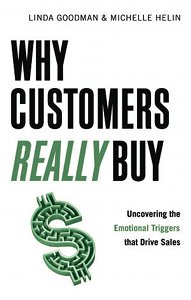
Why Customers Really Buy: Uncovering the Emotional Triggers that Drive Sales book cover
Photos: Career Press, EvinThayer
A newly published book written for sales and marketing professionals addresses issues relating to the emotional triggers the authors believe are behind shoppers purchasing behavior. In a jointly written book, Why Customers Really Buy: Uncovering the Emotional Triggers that Drive Sales (Career Press, $14.99), Linda Goodman and Michelle Helin, business consultants with decades of experience advising Fortune 500 companies, discuss specific and practical guidelines to illustrate how “insights can become useful for converting emotional considerations into actionable solutions.”
They believe that the same emotional motivation that drives consumers to loyally purchase brand products applies to the business to business environment. They explain that unlike other popular methodologies that focus on mapping emotional reactions against existing products or communications messages, Emotional Trigger Research is a proactive technique designed to uncover the core, unfiltered, and spontaneous triggers that drive actions.
They are convinced that these triggers reveal insights that can be useful in creating sales and marketing strategies that may transform companies. The process relies on a combination of questions, listening, and in-depth conversations, to identify the information companies seek.
The 256-page paperback includes local, national and international case studies and is divided into five parts: Discovering the Power of Emotion, Putting Emotional Triggers to Work – Sales, Putting Emotional Triggers to Work – Marketing, Putting Emotional Triggers to Work – Customer Relationships, and Integrating Emotional Logic.

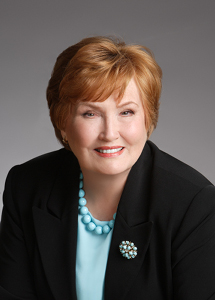
Linda Goodman and Michelle Helin, coauthors, Why Customers Really Buy
Goodman and Helin are independent business consultants who have served as senior sales and marketing officers for Fortune 500 corporations within the hospitality, entertainment, and retail sectors. Past clients, in the United States and around the world, include AT&T Lucent Technology, Schlumberger LTD, GE Corporation, Compaq Computer, Omnicom Group Inc., Staples, Tribe Pictures, and Disney. Goodman’s business, LG Associates, is based in Avon, Connecticut. Helin’s company, Michelle Helin LLC, is based in Houston, Texas.

Click here to buy Why Customers Really Buy: Uncovering the Emotional Triggers That Drive Sales
Posted by Elena del Valle on February 2, 2009
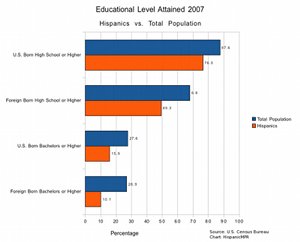
Educational Level Hispanic vs. U.S. Total Population 2007 – click on image
When it comes to advanced degrees foreign-born residents exceed native-born residents, according to a U.S. Census Bureau report released last week. In 2007, more foreign born people living in the United States had master’s degree or higher than native-born residents. Nationally, 11 percent of people born in another country who lived in the United States and 10 percent of U.S.-born residents had an advanced degree.
That same year, 84 percent of adults 25 and older said they had at least a high school diploma and 27 percent claimed to have a bachelor’s degree or higher. At the same time, across the whole country a smaller percentage of foreign-born than native-born adults had completed at least a high school education. Only 49 percent of foreign-born Latinos said they had graduated from high school while 49 percent of Asians indicated they had graduated from college or higher.
While 87.7 percent of U.S.-born residents said they had a high school diploma only 76.5 percent of U.S.-born Latinos graduated from high school; 68 percent of foreign-born residents had a high school diploma and 49 percent of foreign born Latinos had graduated from high school. Undergraduate degrees were less common. Some 27.6 percent of U.S.-born residents said they had a bachelor’s degree or higher and 15.9 percent of U.S.-born Latinos had a bachelor’s degree or higher. Just over one quarter of foreign-born residents (26.9 percent) claimed a bachelor’s degree or higher while 10 percent of foreign born Latinos had such degrees.
In the West, the percentage of foreign-born who had completed at least a bachelor’s degree or higher was less than the percentage of the native-born, 24 percent compared with 31 percent respectively. In the Northeast, both groups had 32 percent with bachelor’s degrees or more. The foreign-born in the South (26 percent) and Midwest (31 percent) were more likely than native-born residents to have at least a college degree (25 percent and 26 percent, respectively).
The report also indicates that: 84 percent of adults 25 and older had completed high school, while 27 percent had obtained at least a bachelor’s degree in 2007; a larger proportion of women (85 percent) than men (84 percent) had completed high school; a larger proportion of men had earned a bachelor’s degree (28 percent compared with 27 percent); the percentage of high school graduates was highest in the Midwest (87 percent), and the percentage of college graduates was highest in the Northeast (32 percent).
Also, men earned more than women at each level of educational attainment. The percentage of female-to-male earnings among year-round, full-time workers 25 and older was 77 percent; workers with a bachelor’s degree on average earned about $20,000 more a year ($46,805) than workers with a high school diploma ($26,894). Hispanic and black workers earned less at all levels than non-Hispanic whites and Asians.
The information in the report is from Educational Attainment in the United States: 2007, a report that describes the degree or level of school completed by adults 25 and older. This data stands out because it’s the first Census Bureau report on educational attainment to use data from the Current Population Survey and the American Community Survey. Researchers point out that combining the two data sets provides a state-by state comparison of educational attainment while providing an examination of historical trends.
Target Latinos effectively by anticipating changes in the market with
“Hispanic Projections with 2007-08 update” audio recording

Presenter Roger Selbert, Ph.D.
Find out
- About Latino buying power growth in the future
- How Latino market growth compares with other markets in the U.S.
- What drives the rise of Latino economic clout
- Who should target the Latino market
- What is the size of the Hispanic affluent market
- If the luxury Latino market is growing
Stay ahead of your competition with “Hispanic Projections”
Posted by Elena del Valle on January 26, 2009

Shira Simmonds, president and co-founder, Ping Mobile
Photos: Ping Mobile, impreMedia
Ping Mobile and impreMedia recently announced a partnership designed to offer mobile advertising and marketing to advertisers via Ping Mobile’s PingRewards platform. According to an impreMedia press release, the company aspires to be the leading U.S. mobile coupon site in Spanish. It is offering Hispanics a series of sweepstakes through print publications and online portals.
The company will offer Spanish speakers discounts through a portal, impreRewards, which is free for users. Its executives hope Latinos will be particularly receptive to marketing offers due to the current economic climate. The idea is to motivate consumers to accept the offers and information directly to their mobile phones by inviting them to carry the coupon content and redemption information on-the-go or in a viral format.
“This partnership represents a tremendous opportunity for advertisers interested in reaching the Hispanic consumer and we are excited to partner with impreMedia, given their unparalleled Hispanic audience in both online and print. Because of the current economic climate, consumers are turning to mobile couponing and it’s these consumers who will benefit from the impreRewards portal,” said Shira Simmonds, president and co-founder of Ping Mobile.
“Best in Class Hispanic Strategies” audio recording


Presenters Carlos Santiago and Derene Allen
-
Find out what makes 25 percent of the top 500 Hispanic market advertisers out perform the remaining companies
-
Discover what questions to ask, steps to take to be a Best in Class company
Click here for more about “Best in Class Hispanic Strategies” audio recording
ImpreMedia plans to provide users access through a keyword and short code to text in to receive individual coupons and encourage platform sign-up. Through their mobile phones, users should be able to text in a short code to receive their coupon and be able to double opt-in into the platform.
ImpreMedia is targeting Spanish Preferred Hispanics 18 to 44 with a household income over $40,000 via its 14 print publications in 17 Hispanic markets and 11 states: Arizona, California, Connecticut, Florida, Illinois, Massachusetts, New Jersey, New Mexico, New York, Pennsylvania and Texas.They plan to measure results and track coupon redemption by looking the exposure of print and online advertising along with opt-in and double opt-in metrics.
They expect to offer advertisers low cost introductory packages up to a specific message count (until messages are served) with the ability to control their message through the promotional period. They are also planning to offer tie-in to SMS offers (text keyword and code) to other ongoing promotional materials that the advertiser has, such as print receipts, online banners, TV or radio spots.

Arturo Duran, chief executive officer, impreMedia Digital
“Given the heavy mobile usage among Hispanic consumers, impreRewards is the perfect solution for any advertiser looking to target the Hispanic market,” said Arturo Duran, chief executive officer of impreMedia Digital. “The solid technology behind Ping’s platform and the ease of use from both the advertisers’ and consumers’ viewpoint, will allow our users to feel comfortable using this exciting, new and innovative marketing tool in their preferred language. Using impreRewards brands nationwide will be able to drive traffic directly to the point of sale within minutes.”
ImpreRewards, built on the same platform and relying on identical back-end technology as PingRewards, promises advertisers full control over campaign details including the content and timetable of each promotion.
ImpreRewards allows users to opt-out anytime by replying with the keyword “Stop.” The company promises that it will keep all consumer information secure. Ping Mobile boasts a coupon campaigns redemption rate of 56 percent on average. Executives at Ping believe high conversion rates are due to the method of SMS distribution they use designed to facilitate that the right messages be being sent to the right consumers. Current advertisers include Footlocker, ESPN Shop, 1-800 Flowers.com, Ice.com, Mikasa, Diamonds International, and World of Watches.
“WorldofWatches.com is thrilled to be a part of this exciting new venture between impreMedia and Ping Mobile. We anticipate the success of mobile couponing to be of great value to us and look forward to offering customers amazing offers on over 3,500 name brand watches, straight to their mobile phones,” said Izac Ben-Shmuel, chief executive officer of the SWI Group.
ImpreMedia is a leading publisher of Spanish language newspapers in the country. The company owns publications in 17 cities and has 26 online and print properties targeting the United States Hispanic population.
Ping Mobile is a full-service mobile agency, that offers a range of mobile marketing, offers, promotions and content services, with a specialization in mobile offers and promotions. The company focuses on consumers, consultancy, reporting, data analysis and client services packages. Ping Mobile is headquartered in Englewood Cliffs, New Jersey and has offices in Los Angeles, California and Tel Aviv, Israel. Ping is comprised of three wholly owned and fully-integrated units: Israel-based Ping Mobile Ltd. (formerly Regisoft Ltd.); Pop Solutions LLC, a Los Angeles-based mobile marketing company; and Ping Mobile, a New Jersey-based mobile marketing company.
“Beyond the 30 Second Spot” audio recording
Listen to a 105-minute discussion




Panelists Ivan Cevallos, Hunter Heller, Kitty Kolding and Cynthia Nelson
Our panel of national experts discuss
• Challenges of measuring the impact of the 30-second ad spot
• Innovative tools are useful to reach Latinos
• Changes in marketing to Hispanics
• On which market segment are the changes most relevant
• Effects of technology and time shift on consumer behavior
• Role of multi-screens
• Getting started
• Tips for marketing professionals
Click here for information on Beyond the 30 Second Spot
Posted by Elena del Valle on January 23, 2009
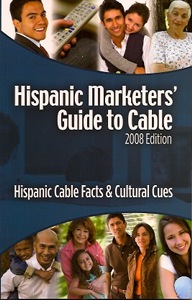
In 2003, the Cabletelevision Advertising Bureau (CAB) published a book about the United States Latino market to drive a heightened understanding of that growing and desirable market among potential advertisers. It was the organization’s first diversity publication. A second edition of that book would be published before, in 2007, the New York based organization published Race Relevance and Revenue, a 150-page book about the African-American marketplace. Discussions are in the works for a similar publication about Asian markets in the United States.
Late in 2008, the Bureau published Hispanic Marketers’ Guide to Cable 2008 Edition Hispanic Cable Facts and Cultural Cues ($49.95) to provide an updated resource for advertisers and their agencies. This third edition of the book was possible with a budget of $50,000 and the help of 12 contributors. It was designed to assist marketers to reach out to diverse Hispanic cable viewers, especially Spanish speakers who, according to the book, are particularly well represented by cable brands.
“We expect this to be the must-have guide for this year,” said Cynthia Perkins-Roberts, vice president of Multicultural Marketing and Business Development of the Cabletelevision Advertising Bureau. “We decided to take a different approach. It’s a multidimensional market. The strength of cable is that it reaches all the (Hispanic) segments. The book includes cultural cues and viewing information divided by segments of the population. This makes the book unique and mirrors the true industry.”
The publishers promise an explanation of the role of cable television in marketing to Latinos; why they believe cable is one of the fastest growing television options; information about the options available to reach Hispanics; details about the options cable offers Latino viewers; information on the major Hispanic market segments; insights on how marketers can connect with market sub groups; suggestions on how to approach Latino consumers; information on acculturation; insights on media habits and how they vary by generation; and information about English dominant Hispanics.
The organization printed 5,000 copies of the book and has distributed 1,500 to date. The book is divided into two halves: Hispanic TV Facts and Cultural Cues. The first half, relying on A Business Rationale, Geographic Targeting and Hispanic-Targeted Programming Options discussions, makes a case for cable as an ideal advertising vehicle to reach Latino viewers. The Business Rationale is divided into Choice, Growth, A Proven Entity, Prime Consumer Targets, Brands that Build Brands, Versatility and Consistency and Extended Reach.
The Cultural Cues half includes: an overview of the Hispanic population, Hispanic Men, Hispanic Women, Hispanic Youth, Acculturation, English Dominant and Hispanic Generations. Market information was provided by Cheskin Added Value, Experian, Felipe Korzenny, Ph.D., Franco Research Group, Latin Force, Milward Brown, The Nielsen Company, Gonzalo Perez, Terry Soto, Synovate and TNS. Some of the contributors submitted content on a pro bono basis.
Founded in 1980, the Cabletelevision Advertising Bureau is a cable television advertising advocacy group dedicated to providing advertisers media insights. The organization includes a division dedicated to diversity markets that provides advertisers information on Asian, Hispanic and African-American markets in the United States.

Click here to buy a copy of Hispanic Marketers’ Guide to Cable
Comments:
Filed Under: Books
Posted by Elena del Valle on January 9, 2009
I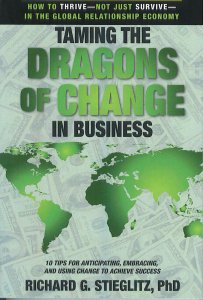
Dragons of Change in Business book cover
In Taming the Dragons of Change in Business 10 Tips for Anticipating, Embracing and Using Change to Achieve Success (Acuity Publishing, $19.95), Richard G. Stieglitz, Ph.D. explores ways for readers to take advantage of current market, employment, organizational and business shifts. The Maryland resident believes that individuals and companies who are prepared and ready may be able to take advantage of the opportunities that develop in the rapidly changing environment.
Stieglitz, who believes the most notable change is the increased importance of relationships in the business environment, addressed the book to leaders who want to transform their organizations. He divided the book into three sections: Beliefs The Foundation for Success; Relationships Building Blocks of Success; and Actions Only Actions Change Reality. He shared three tips in each of the first two and four tips in the third one.
The three tips in the first section are Abundance Be Abundant in Your Attitude; Opportunity Answer When It Knocks; and Investments Pay It Forward. The tips for the second section are: Communications Get Your Message Across Clearly; Diversity Embrace Diversity to Expand Creativity; and Collaboration Collaborate, Collaborate, Collaborate. The tips for the final section are: Purpose Use Purpose to Set Your Direction; Planning Plan to Achieve Your Goals; Innovation Reach the Top Through Innovation; and Execution Execute to Produce Results.
He dedicated the final eight pages of the book to what he considers are ten future changes: An increase in independent workers; increased customization; more direct communications thanks to technological advances; pressure for high skilled workers to adapt to business demands; heightened importance of creativity; more social change than ever; shifting world market that will drive economic relationships; closer relationships resulting from global markets; a shrinking business environment pressures leaders to sustain healthy relationships; and greater uncertainty.
A nuclear engineer by training, Stieglitz has a 35-year career track. He served 10 years in the United States Navy and then pursued a career in the private sector where he worked for software and aerospace firms. He also authored Taming the Dragons of Change 10 Tips for Achieving Happiness and Success When Everything Around You is Changing.
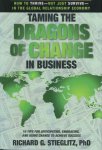
Click here to buy Taming the Dragons of Change In Business
Comments:
Filed Under: Books
Posted by Elena del Valle on December 19, 2008

¡Sabor! A Passion for Cuban Cuisine book cover
Photo: Running Press
Would you like to try something a little different at dinner for the holidays? Do you like Latin food that’s tasty but not red hot? Perhaps Cuban food is just what you need.
In Sabor! A Passion for Cuban Cuisine (Running Press, November 2008,
$29.95), Ana Quincoces Rodriguez, a Miami, Florida resident and amateur cook, offers a look at the food and flavors of Cuba. She starts out outlining what she describes as the “holy trinity” of Cuban cuisine, garlic, bell pepper, and Spanish onion.
She titled the book Sabor, Spanish for flavor, because for her it describes the many aspects of cooking, saying that it’s possible to cook with sabor, speak with sabor, and dance with sabor; and that in “Cuba, sabor is both a state of mind and a way of life.”
The 240-page hardcover book has 130 recipes, many accompanied by full page color photos. Although the chapter titles are in Spanish and English, the rest of the content, including the list of ingredients, is in English. It is divided into: Some Basics, Appetizers and Snacks, Soups and Sandwiches, Sides and Salads, Main Dishes, Desserts and Drinks. At the end, there are Sample Menus, Glossary, Sources Guide and Conversion Tables.
Popular recipes she features in the book include: Croqueta Preparada (Cuban Sandwich with Croquettes); Mariquitas (Fried Plantain Chips) with Mojo Criollo (Garlic Sauce); Frituras de Bacalao (Cod Fritters); Empanadas de Chorizo (Chorizo Turnovers); Bistec de Palomilla (Minute Steak); Pierna Asada (Roast Pork Leg); Tostones (Fried Green Plantains); and Flan de Coco (Coconut Flan).
Rodriguez, who grew up in Miami, learned to cook at her Cuban mother’s side. She has been mentioned in several magazines and newspapers and on national television after self-publishing her first book, Cuban Chicks Can Cook. She lives in Miami, with her husband and two teenage daughters.

Click here to buy Sabor!: A Passion for Cuban Cuisine
Comments:
Filed Under: Books







































